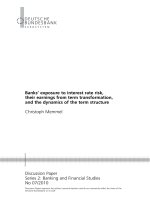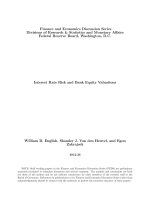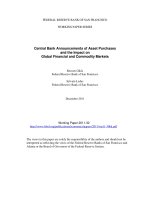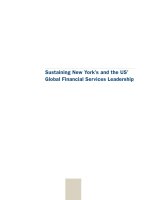Managing global financial and foreign exchage rate risk
Bạn đang xem bản rút gọn của tài liệu. Xem và tải ngay bản đầy đủ của tài liệu tại đây (12.49 MB, 403 trang )
Managing Global
Financial and Foreign
Exchange Rate Risk
GHASSEM A. HOMAIFAR
John Wiley & Sons, Inc.
Managing Global
Financial and Foreign
Exchange Rate Risk
John Wiley & Sons
Founded in 1807, John Wiley & Sons is the oldest independent
publishing company in the United States. With offices in
North America, Europe, Australia, and Asia, Wiley is globally
committed to developing and marketing print and electronic
products and services for our customers’ professional and
personal knowledge and understanding.
The Wiley Finance series contains books written specifically
for finance and investment professionals as well as sophisticated
individual investors and their financial advisors. Book topics
range from portfolio management to e-commerce, risk
management, financial engineering, valuation and financial
instrument analysis, as well as much more.
For a list of available titles, please visit our Web site at
www.WileyFinance.com.
Managing Global
Financial and Foreign
Exchange Rate Risk
GHASSEM A. HOMAIFAR
John Wiley & Sons, Inc.
This book is printed on acid-free paper. �
�
Copyright © 2004 by John Wiley & Sons, Inc., Hoboken, New Jersey. All rights reserved.
Published simultaneously in Canada.
No part of this publication may be reproduced, stored in a retrieval system, or transmitted
in any form or by any means, electronic, mechanical, photocopying, recording, scanning,
or otherwise, except as permitted under Section 107 or 108 of the 1976 United States
Copyright Act, without either the prior written permission of the Publisher, or authorization
through payment of the appropriate per-copy fee to the Copyright Clearance Center, Inc.,
222 Rosewood Drive, Danvers, MA 01923, 978-750-8400, fax 978-750-4470, or on the
Web at www.copyright.com. Requests to the Publisher for permission should be addressed
to the Permissions Department, John Wiley & Sons, Inc., 111 River Street, Hoboken, NJ
07030, 201-748-6011, fax 201-748-6008, e-mail:
Limit of Liability/Disclaimer of Warranty: While the publisher and author have used their
best efforts in preparing this book, they make no representations or warranties with respect
to the accuracy or completeness of the contents of this book and specifically disclaim any
implied warranties of merchantability or fitness for a particular purpose. No warranty may
be created or extended by sales representatives or written sales materials. The advice and
strategies contained herein may not be suitable for your situation. You should consult with
a professional where appropriate. Neither the publisher nor author shall be liable for any loss
of profit or any other commercial damages, including but not limited to special, incidental,
consequential, or other damages.
For general information on our other products and services, or technical support, please
contact our Customer Care Department within the United States at 800-762-2974, outside
the United States at 317-572-3993 or fax 317-572-4002.
Wiley also publishes its books in a variety of electronic formats. Some content that appears in
print may not be available in electronic books.
For more information about Wiley products, visit our Web site at www.wiley.com.
Library of Congress Cataloging-in-Publication Data
Homaifar, Ghassem.
Managing global financial and foreign exchange rate risk /
Ghassem A. Homaifar.
p. cm. — (The Wiley finance series)
Includes bibliographical references and index.
ISBN 0-471-28115-8 (CLOTH)
1. Foreign exchange. 2. Foreign exchange rates. 3. Risk management.
4. Foreign exchange — United States. 5. Foreign exchange rates — United States.
6. Risk management — United States. I. Title. II. Series.
HG3851.H63 2004
332.4'5— dc22
2003015159
Printed in the United States of America.
10 9 8 7 6 5 4 3 2 1
To my wife and daughters
contents
Preface
CHAPTER 1
Global Markets: Transactions and Risks
xv
1
Savings and Loans Problems
Agency Problems
Types of Markets
Types of Transactions
Types of Risks
2
3
5
7
10
CHAPTER 2
Balance of Payments Exposure Management
15
Balance of Payments as a Source and Use of Funds
Components of Balance of Payments
Current Account and Economic Fundamentals
Capital Account, Expectation, and Interest Rate
U.S. Balance of Payments: Recent Evidence
Exposure Related to Capital Account
Exchange Rate Arrangements, Dollarization, and Peg
Managing Balance of Payment Exposure in the
Emerging Market Economies
Case Study: Kairos Capital
17
17
19
21
21
23
28
32
33
CHAPTER 3
Foreign Exchange Rate Dynamics: Managing Exposure
39
Foreign Exchange Markets
Foreign Exchange Transactions
Foreign Exchange Market Functions
39
39
45
vii
viii
Foreign Exchange Quotations
Cross-Exchange Rate
Bid and Offer Quotations in the Interbank Market
Arbitrage in the Foreign Exchange Market
Major Players in the Foreign Exchange Market
Speculative Transactions
Foreign Exchange Loss
Settlement Risk
Spot Rate and the Law of One Price
Big Mac Index
Central Bank Intervention
Relative Version of Purchasing Power Parity
Exchange Rate Pass-Through
Spot Exchange Rate and Nominal Interest Rate
Forward Exchange Rate and Covered Interest Parity
Forward Premium or Discount for
Selected Currencies
International Parity Relationship
Real Exchange Rate
Real Exchange Rate and East Asian Currency Crisis
Case Study: Real-World Furniture, Inc.
CHAPTER 4
Application of Options and Futures for Managing Exposure
Determinants of the Option Price (Premium)
Options Traded in Organized Exchanges
Sensitivity of Put and Call Price to Underlying Factors
Functions of Options and Futures
Hedging Receivables Denominated in Foreign Currency
Speculation on the Futures Premium or Discount
Hedge Ratio
Price Discovery of Options and Futures
Regulatory Arbitrage
Binomial Option Pricing
Hedged Portfolio
Derivatives Application in Practice
CONTENTS
45
46
47
47
47
50
50
51
51
52
54
56
59
61
62
65
66
66
68
69
75
75
77
79
82
86
91
93
95
96
96
99
100
Contents
ix
Synthetic Forward Contract
Case Study: Applications of Futures Contracts in
Portfolio Hedging
102
CHAPTER 5
Principles of Futures: Pricing and Applications
107
Cost of Carry
Stock Index Futures
Index Arbitrage
Portfolio Insurance
Hedging with Stock Index Futures Options
Basis Risk
Changing the Beta of the Portfolio with Futures
Anticipatory Hedge with Stock Index Futures
Case Study: Competition for Safeway, PLC
Managing Exposure of an Individual Stock
Currency Futures
Hedging with Currency Futures
Anticipatory Hedging of Weakening Currency
Rolling Over the Futures Hedge
Marking to Market and Margin
Commodity Futures
Spread Position
Hedging with Commodities Futures
Empirical Evidence: Forward and Future Prices
Case Study: Chockletto International Hedging
107
108
109
113
115
119
120
122
123
124
124
126
128
129
131
132
133
134
138
140
CHAPTER 6
Interest Rate Futures: Pricing and Applications
143
Treasury Bills Futures
Spot Rate
Forward Rate
Determinants of the Shape of the Term Structure of
Interest Rates
Approximate Duration
101
144
144
146
148
154
x
CONTENTS
Pricing Treasury Bill Futures
Eurodollar Futures
Treasury Notes Futures
Treasury Bond Futures
Conversion Factor
Arbitrage in the Interest Rates Futures Market
Pricing Synthetic Futures or Forward
Hedging with Futures: Duration-Based Approach
155
156
158
160
162
165
165
168
CHAPTER 7
Swaps
177
Interest Rate Swaps
Forward Rate Agreement
Interest Rate Conventions
Stripes of Forward Rate Agreements
Motivations for Swaps
Swaps Due to Comparative Advantage
Swap Valuation
Interest Rate Caps, Floors, Collars,
and Corridors
Volatility of Interest Rates
Swaptions
Callable Swap
Putable Swap
Warehousing Swap
Swaps Risks
Exotic Swaps
Currency Swaps
Break-Even Analysis of Swap and Refinancing
Options Embedded in Currency Swaps
Three-Way Swaps
178
178
181
181
183
185
188
190
198
200
201
202
203
203
206
207
211
212
213
CHAPTER 8
Translation, Transaction, and Operating Exposure
217
Translation Exposure
217
Contents
Case Study: Accounting Exposure
Functional Currency
Managing Translation Exposure
Balance Sheet Hedging
Transaction Exposure
Operating Exposure
Hedging in Practice: Nike and DuPont
Exposure Netting
Forward Hedging: Example
Money Market Hedge
Hedging with Futures
Option Hedging
Value at Risk
Two Assets Portfolio
Lufthansa Buys Aircraft from Boeing
Managing Operating Exposure
Fixed for Fixed Currency and Interest
Rate Swaps
CHAPTER 9
Debt, Equity, and Other Synthetic Structures
Inverse Floater
Creating a Synthetic Fixed Rate
Synthetic Structures
Mortgage- and Asset-backed Derivatives
Prepayment Risks
Sequential-Pay Collateralized Mortgage Obligations
Interest Only and Principal Only
Equity-Linked Debt
Zero Coupon Bond Linked to Goldman Sachs
Commodity Index
Global Diversification with Swaps
Catastrophe Bonds
Liability Management with Derivatives
Spread on Treasury Yield Curve
xi
220
222
223
223
224
224
225
226
226
228
231
233
235
237
238
243
249
253
253
256
258
259
259
261
261
263
264
265
266
266
275
xii
CONTENTS
CHAPTER 10
Options on Futures
279
Spreads
Bull Spreads
Bear Spreads
Butterfly Spreads
Box Spreads
Long Straddle
Short Straddle
Calendar Spread
Strips
Straps
Price and Yield Volatility
Spread Trades on Treasury Curves
Exotic Options
281
281
283
284
285
288
289
290
292
294
296
297
301
CHAPTER 11
Credit Derivatives: Pricing and Applications
307
Credit Derivatives Products
Credit Event/Default Swap
Pricing Credit Default Swap
Unwinding and Assignability of Credit Default Swaps
Default Probability
Break-Even High-Yield Bonds
Default Risk/Return
Creating Synthetic Assets
Synthetic Credit Default Swaps
Credit Default Swap Applications
Restructuring
Credit-Linked Notes
Synthetic Collateralized Loan Obligations
Objectives of Structuring Collateralized
Loan Obligations
Synthetic Collateralized Loan Obligations
Synthetic Arbitrage Collateralized Loan Obligations
Synthetic Balance Sheet Collateralized Loan Obligations
308
309
312
315
318
320
321
321
323
323
324
326
327
329
329
331
332
Contents
xiii
Capital Adequacy Requirements
Credit Exposure Method
Total Return Swaps
333
334
335
CHAPTER 12
Credit and Other Exotic Derivatives
341
Credit Spread Forward
Credit Spread Option
Asset Swap Switch
Callable Step-ups
Transfer and Convertibility Protection
Pricing Transfer and Convertibility Protection
Speculative Capital
Emerging Market Debts and Brady Bonds
International Swaps and Derivatives Association
Master Agreement
Weather Derivatives
Weather Derivatives Market
Exchange-Traded Weather Derivatives
CME Futures
CME Options
Swaps
342
342
344
347
348
353
354
354
References
365
Index
373
356
357
358
359
360
362
363
H1 head
xv
preface
R
isk taking is the foundation of the capitalist economy as it is positively correlated to the reward for entrepreneurial behavior. Risk management in the
twenty-first century integrates mathematical and physical science along with that
of behavioral finance and economics. The end result is a mushrooming set of
derivative products where price is contingent on the behavior of underlying assets,
such as stocks, bonds, commodities, currencies, indices, and other exotic instruments. The market for derivatives plays an ever-increasing important role in transferring risk from risk-averse individuals and institutions to those who are willing
to take it for a profit. Risk taking and risk management are balanced in the marketplace by regulatory oversight, as bank and financial services industry regulators continue to search for an optimum balance that protects the integrity of the
banking system and provides regulatory capital relief while enhancing the return
on capital to financial institutions.
This book is intended to provide readers who already have an understanding
of the time value of money the opportunity to venture into the exciting and often
mysterious world of global derivatives. In various derivative textbooks, the pricegenerating function of derivatives is expressed as a highly complex mathematical
manipulation that is unintelligible to a broad audience. This endeavor is intended
to bridge the gap between theory and practice by focusing on understanding various derivatives for managing exposure to foreign exchange, commodity price,
interest rate, and credit and weather risks.
The objective is to present a coherent analysis of the various risks that a
multinational firm faces in an integrated global market and to consider active risk
management approaches for mitigating exposures to commodity price, foreign
exchange, equity price, and interest rate changes within the context of value creation for its stakeholders. Numerous real-world examples are employed to illustrate how derivatives can be used to mitigate risks. To those whose work has been
cited throughout this book, I am indebted for their contributions to the knowledge
base that has revolutionized the practice of risk management. Wall Street’s brightest minds continue to respond to changes in the regulatory landscape, changes
in tax laws, and changes in business and financial risks with further innovations
in derivatives and financial engineering.
This book is organized into 12 chapters. Chapter 1 provides an overview.
Chapter 2 addresses the balance of payments (BP) equilibrium and managing
exposures related to the disequilibrium in the various components of BP. Some
xv
xvi
MANAGING GLOBAL FINANCIAL AND FOREIGN EXCHANGE RATE RISK
preliminary results for the U.S. balance of payments are presented and compared
to recent evidence from the emerging market economies of Southeast Asia.
Chapter 3 outlines a simple and unified framework for the dynamic process
of international rate parity relationships along with managing exposures induced
due to changes in foreign exchange rates. Furthermore, the economic consequences of the partial and incomplete exchange rate pass-through provide interesting observations and challenges for U.S. multinational corporations. This
chapter concludes with a framework for the macrodetermination of the exchange
rate linking the real sector of the economy, where production takes place, with
the financial markets and monetary policy formulation by the Federal Reserve
Board, where financing is encouraged (discouraged).
Chapter 4 lays out the foundation of option pricing in a fairly simple context and its application for managing risk. Hedging foreign-denominated cash
inflows and outflows using call and put options provides the reader with opportunities to challenge the conventional wisdom of hedging and not hedging. The
question of whether to hedge or not to hedge explains the cost and benefits of
hedging with options vis à vis hedging with forward or futures contract. The chapter concludes with an example of covered call, protective put, and zero collar and
its implications for managers.
Chapter 5 outlines the principles of futures pricing and application for
dividend-paying instruments such as stock index and currency futures. The pricing formulation prepares, in a relatively nontechnical way, the foundation for the
understanding of the relatively complex derivatives instruments discussed throughout the book. Nondividend-paying futures such as gold, silver, and other commodity futures are priced in the context of cost of carry model.
Anticipatory hedging with various futures, such as stock index, currency, and
commodities, is provided in the context of illustrative cases that permits readers
to follow the peculiarities of the futures and forward contracts as well as highlighting their idiosyncrasies. The final section of the chapter presents some of the
most recent evidence on the forward and futures prices.
Chapter 6 presents principles of pricing and application of interest rate
futures, such as Treasury bills, notes, bonds, and Eurodollar futures, for managing exposure due to interest rate and price risk. The shape of the term structure
of interest rates provides readers with various theories of the interest rates as the
foundation of the interest-sensitive derivative instruments that has revolutionized
the financial services industry in the last two decades. The price volatility of bonds
such as duration and convexity provides readers with a clear and coherent analysis of these important factors in active bond portfolio management. The delivery
process in the futures market illustrates the institutional aspects of the cheapestto-deliver bonds in the Treasury notes and bonds market.
Arbitrage and risk transfer from hedgers to speculators in interest rate futures
market in the context of easy-to-follow examples provide readers with an in-depth
analysis of this important subject. Hedging with a duration-based approach illustrates the application of the various interest rates futures using long and short
hedges for managing exposure to interest rate risk.
Preface
xvii
Chapter 7 lays out the foundation of the swaps. In the finance nomenclature, selling an asset and buying another asset simultaneously, and vice versa, is a
swap. The markets for interest rate and currency swaps are some of the most innovative in the world. A new breed of swaps are introduced in the over-the-counter
market in restructuring assets/liabilities, and mitigating and transferring risk. This
chapter provides an extensive analysis of the valuation of the plain-vanilla interest rate and currency swaps and their application to interest rate risk management.
Pricing and valuation of caps, floors, collars, and corridors along with their application is presented in a framework that can be easily understood by readers with
a minimal background in the time value of money. Valuation and application of
swaptions is highlighted with numerous examples and graphical illustrations. The
swap risks and exposure associated with swaps can be substantial, as regulatory
authorities have imposed capital reserve in protecting the soundness of the banking system in swaps transactions that used to be treated off balance sheet and
footnoted in the past. Currency swaps are analyzed along the same lines as their
interest rate counterpart in a plain-vanilla type and embedded with various options
making them callable, cancelable, exchangeable, and so on.
Chapter 8 analyzes the effect of the unexpected change in exchange rates:
on the single-period cash flows (transaction exposure), multiperiod cash flows
(operating exposure), and accounting-induced changes in the consolidated balance sheet (accounting exposure). This chapter unifies the fundamentals of hedging transaction, economic (operating), and translation (accounting) exposures with
various derivatives in a user-friendly framework. The chapter highlights managing
transaction exposure for Lufthansa Airlines’ acquisition of aircrafts from Boeing
in 1985 by a cost-benefit analysis of various hedging instruments for mitigating
airline exposure to foreign currency exchange rate risk. The chapter also reviews
the current literature on the practice of U.S. multinational corporations in regard
to their hedging activities on such firms as DuPont and Nike. Analysis of value
at risk (VAR) for the exposures related to changes in commodity prices, interest
rates, and market risk are illustrated with numerous easy-to-follow examples. The
mandate of regulatory authorities in bank supervision requiring banks to hold
capital reserve for risky assets have increased the importance of VAR analysis for
financial and nonfinancial corporations.
Chapter 9 outlines the nonstandard debt derivatives developed in the overthe-counter market to transfer risk, to mitigate reinvestment rate risk, to transfer
the prepayment risk from a class of bond to other classes, to mitigate price and
exchange rate risks, to increase liquidity, to reduce agency costs, to reduce transaction costs, and to reduce tax burden circumventing regulatory restrictions. The
nonstandard derivative products offer opportunities in the financial market to
enhance the yield and reduce the risk if properly combined with other assets in the
portfolio. Therefore, they demand an understanding of the underlying factors
that determine their value. The reward is higher, as is the risk of the individual
derivative product. It is imperative to fully understand the pricing mechanism
before committing the capital. Pricing inverse floaters along with floaters and their
application in an active bond portfolio management is illustrated at the outset.
xviii
MANAGING GLOBAL FINANCIAL AND FOREIGN EXCHANGE RATE RISK
Numerous examples explain using inverse floaters to create synthetic fixed rate.
Mortgage and asset-backed derivative securities, as well as the price, yield, and
prepayment risks, provide the idiosyncrasies of these instruments. The chapter
also analyzes prepayment risks such as extension and contraction risks. The
interest-only (IO) and principal-only (PO) securities derived synthetically from
fixed rate instruments reveal an interesting phenomena regarding their price and
yield relationship. This chapter concludes with the equity-linked debts and the
implication for global diversification and liability management with such derivatives as caps, floors, collars, and swaptions.
Chapter 10 provides an overview of options on the interest rates, currencies,
indices, and commodity futures products, such as options on spreads position on
the Eurodollar futures, the Treasury futures, the currency futures and commodity futures. The currency options that began trading at the Philadelphia Exchange
in 1982 to respond to the needs of multinational corporations for hedging currency exposure as well as to the needs of arbitrageurs and speculators to garner
speculative profits (losses). Options in the interest rate products were introduced
by the Chicago Mercantile Exchange in 1985. Various options positions for hedging and speculating are illustrated using real-life exposures. The options on
futures are very similar to the options on equities and are priced accordingly using
standard Black-Scholes options pricing formula. Spreads positions, such as bear
spreads, bull spreads, butterfly spreads, box spreads, short straddle, long straddle, strips, and straps, are illustrated with numerous examples. The final section
of the chapter discusses exotic options, variants of the ordinary options where the
spot price, strike price, maturity, and/or volatility of the options are embedded
with options. For example, the text discusses allowing the spot price to be determined by its behavior over the option period as opposed to one price at the
expiration or exercise date (whichever comes first) or by making the spot price
path-dependent, where the frequency of trading or number of days that options
have for expiration to be used for establishing average spot price.
Chapter 11 discusses credit derivatives and default insurance, the new breed
of on– and off–balance sheet financial instruments of the last five years that allow
banks and other financial corporations to transfer or assume credit risk on a
specific “reference” asset or portfolio of assets. The increased application of the
derivatives has raised concerns about the default risk properties of these instruments. These concerns have been mitigated by the Bank for International Settlement, as it imposed a risk-based capital ratio in 1992, requiring banks to hold
capital reserves to cover the unexpected losses on the current and future replacement cost of these instruments in the event of default. The number of credit
derivatives is growing as new instruments are developed by financial engineers in
response to changes in regulatory climate, taxes, increased volatility, and change
in supply and demand condition. Credit derivatives enable the parties to reduce
credit exposure without physically removing assets from the balance sheet. For
example, loan sales and unwinding or assignment of loans require consent and
notification of the counterparty. However, transactions on credit derivatives are
confidential and do not require notification of the customer, thereby separating
Preface
xix
the fiduciary relationship from risk management decisions. The credit derivatives discussed in this chapter, such as credit default swap, synthetic collateralized loan obligations, asset swaps, total return swaps, and credit-linked notes,
allow efficient allocation of economic capital, resulting in diversification of risk
and improved shareholder returns.
Chapter 12 reviews some of the recent exotic innovations in credit and
weather derivatives. The regulatory changes in treatment of derivative transactions, whether booked in the bank balance sheet or in the bank trading desk,
continue to have significant impact on the return on capital as the Bank for International Settlement searches for an optimum capital reserve requirement that
protects the integrity of the banking system as well as providing sufficient regulatory and economic capital relief. The chapter starts with a discussion of highly
leveraged transactions, such as credit spread forward, credit spread options, option
on credit exposure, asset swap switch, and callable step-ups. These derivative products are designed to transfer risks synthetically in the capital markets. Numerous
examples illustrate pricing and application of transfer and convertibility protection. A discussion of emerging market bonds and stripped Brady bonds follows.
Finally, the chapter presents pricing and application of weather derivatives.
I am indebted to my 2002 – 2003 MBA class at Middle Tennessee State University for reading various chapters and providing valuable input for improving
the clarity of the material. I am grateful for those who provided case studies. My
thanks and appreciation go to Reuben Kyle, Larry Farmer, Jeannie Harrington,
Lee Sarver, Frank Mitchelo, James Feller, Mahmoud Haddad, Bichaka Fayissa,
John Lee, Mamit Deme, Albert Deprince, Emily Zietz, Kenneth Hollman, Amy
Daly, Natasha Bradford, David Brown, Todd Horton, Michael Deweese, Rob
Whitley, Kathryn Mackorell, Pichet Panee, Melissa Wilson, Chris Curry, Butch
Nunely, and Rich Stone for their insightful comments on various chapters and
to my graduate assistants, Yan Liu and Zhijie Qi, for research support. I remain
solely responsible for any remaining errors. Special thanks to my editor, Sheck
Cho, for his valuable input that improved the clarity of my presentations, and
to Karen Ludke, Sujin Hong, and Jennifer Hanley for editorial assistance at John
Wiley & Sons. Last but not least, I remain indebted to my wife and daughters
for their unconditional support.
CHAPTER
1
Global Markets:
Transactions and Risks
T
his chapter outlines the foundation of this book in managing and mitigating
various exposures that a firm faces in a global context. What is truly revealing is that exposure is defined by Webster’s New World Dictionary as “the fact
of being exposed in a helpless condition to the elements.”1 The elements can be
(unforeseen) macro- or microfactors unique to the company. Fortunately, for events
that might be unforeseen, such as death or natural disasters, the markets have
developed various types of insurance for managing and transferring those risks
to risk arbitrageurs (various types of insurance companies). What remains to be
managed is the macrorisk — market risk that cannot be avoided, but can at times
be mitigated — and microrisk — the unique risk that is peculiar to a company—
which needs to be managed properly.
Exposure has increased for the major players in the market as the world
economy has seen a major restructuring of financing transactions since March
1973 (the beginning of floating rate arrangement). The increased volatility of
exchange rates and innovations in derivative products has created opportunities
and challenges to corporations. Exhibit 1.1 shows the percentage monthly change
in yen/$ exchange rates 1957 through 2002. Notable in the exhibit is the beginning of the floating rate arrangement in 1973 and the subsequent significant
Monthly Percentage Change ¥/$ (1957– 2002)
0.08
2001.05
2000.03
1999.01
1997.11
1996.09
1995.07
1994.05
1993.03
1990.11
1992.01
1989.09
1988.07
1987.05
1986.03
1985.01
1983.11
1982.09
1981.07
1980.05
1979.03
1978.01
1976.11
1975.09
1974.07
1973.05
1972.03
1971.01
1969.11
1968.09
1967.07
1966.05
1965.03
1964.01
1962.11
1961.09
1960.07
1959.05
Ϫ0.02
1958.03
0.03
1957.01
Percentage Change in Monthly
Exchange Rate (¥/$)
EXHIBIT 1.1
Ϫ0.07
Ϫ0.12
Time (monthly data)
1
2
GLOBAL MARKETS: TRANSACTIONS AND RISKS
increase in the volatility of the exchange rate, particularly in the periods 1973 –74,
1979 – 80, and 1995 – 96. The percentage changes in the yen/$ exchange rate
appears to be randomly distributed. Chapter 3 provides further discussion of the
implications of this randomness for decision making.
The absence of volatility in the foreign exchange market for yen/$ prior to
the floating rate arrangement is also notable. This period coincided with the fixed
exchange rate arrangement of 1945 to 1971 known as the Bretton Woods Arrangement, while allowing occasional dollar devaluations in 1934 when dollar devalued to $35/ounce of gold from $20.67/ounce to remedy a huge U.S. deficit. The
dollar was devalued to $38/ounce of gold on December 17–18, 1971, in an agreement that came to be known as the Smithsonian Agreement. Despite these devaluations, March 1973 marks the end of a fixed exchange rate arrangement where
the British pound and Swiss franc were allowed to float respectively on June
1972 and January 1973. By June 1973, the dollar lost an average of 10 percent.
Most firms were able to rise to the occasion, adapt to the new challenges,
and prosper. Some have not fared so well; in extreme cases, firms have become
dinosaurs unable to adapt to environmental changes and face extinction. Savings and loans (S&Ls) and Laker’s Airline are the classic examples of the dinosaurs
unable to mange their exposure.
SAVINGS AND LOANS PROBLEMS
S&Ls had high-duration assets on the left-hand side of the balance sheet in
the form of mostly fixed rate mortgages, while they were funded on the righthand side of the balance sheet with mostly low-duration, short-term floating rate
demand deposit and fixed rate time deposits of two to five years maturity.
Exhibit 1.2 provides the monthly change in basis points for one-year Treasury
bills (T-bills) since 1953. The monthly basis point change in one-year T-bills
dramatically increased in the late 1970s due to double-digit inflation, which
raised the exposure for the financial institutions, particularly the S&Ls.
EXHIBIT 1.2
One-Year Monthly First Difference for T-Bills (1953 – 2002)
3
2
0
Ϫ1
1953
1954
1955
1956
1957
1959
1960
1961
1962
1963
1964
1966
1967
1968
1969
1970
1971
1973
1974
1975
1976
1977
1978
1980
1981
1982
1983
1984
1985
1987
1988
1989
1990
1991
1992
1994
1995
1996
1997
1998
1999
2001
Basis Points
1
Ϫ2
Ϫ3
Ϫ4
Ϫ5
Time (monthly data)









